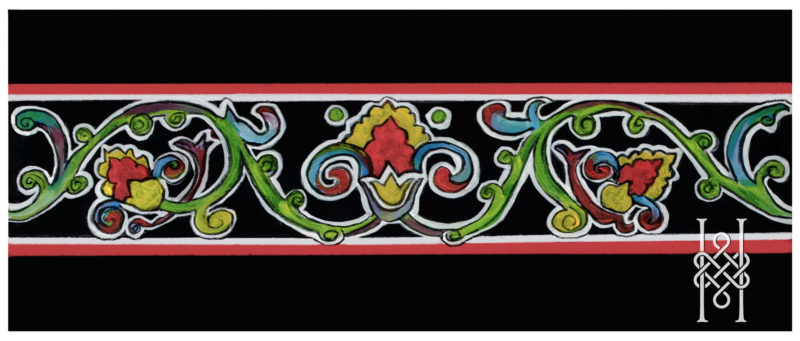Border with Flower Motif
Flower and foliage have been a favourite theme in embroidery for centuries. During the early Middle Ages embroiderers and painters worked together to create flower motifs and then as science introduced perspective to art, plant drawings became more realistic. Skills separated into art and craft and folk art kept the artform alive by continuing to use the traditional motifs. Traditional embroidery and plant designs are still valued in China, India, Morocco, Scandinavia, and Mexico and are found in the home.

Flower motif in a border design
How the Ideas Spread
Artists and embroiderers have always changed designs to suit their materials. As a result, designs were adapted to local needs and moved from one country to another.
Ideas and plant motifs spread with trade, the Crusades, and the spread of Christianity.
- Ecclesiastical embroidered garments made of silk,
- Greek tunics and togas,
- Chinese stitched flower symbols on silk
- nuns teaching in monasteries and in missions
Embroidery patterns were adapted to suit different fabrics and needs. Flower motifs became stylised to suit the stitches, and simple shapes were best for needle and thread.
Tree of Life design
From the sixteenth century different techniques developed all over Europe. Printed oriental cottons influenced seventeenth century Jacobean embroidery in England and a Tree of Life theme developed. The Jacobean style which mastered the Tree of Life became popular. Subsequently it was used in decorative hangings and furnishings in the home.
By the end of the nineteenth century there was a revival of interest in the flower motif with William Morris and his company Morris & Co. The Tree of Life was still prominent. Flowers and especially the artichoke became more realistic and were used as floral motifs in wallpaper. Jessie Newberry at the Glasgow School of Art taught embroidery. Her style later morphed into Art Nouveau with the free-flowing spirals and elegant lines in linen applique works. Foliage as tendrils added scrolls and spirals.
In this border design the natural blossom has been rendered into an exotic Jacobean style with flower with spiral leaves. It is not a copy from nature but a stylized motif that is semi- abstract. It is influenced by the lotus and palmette from early Celtic Art, Egyptian, Greek and Roman art. Lines and curves repeat in the twisted stem with leaf scrolls in a wave pattern. This border design is symmetrical and can be used as a border in embroidery, wood carving, pottery, and painting.
A love of plants and flowers from the natural world never dies. Botanical illustrations record the exact details and photographic likeness, but embroidery as art, expresses the human need to connect with nature.
